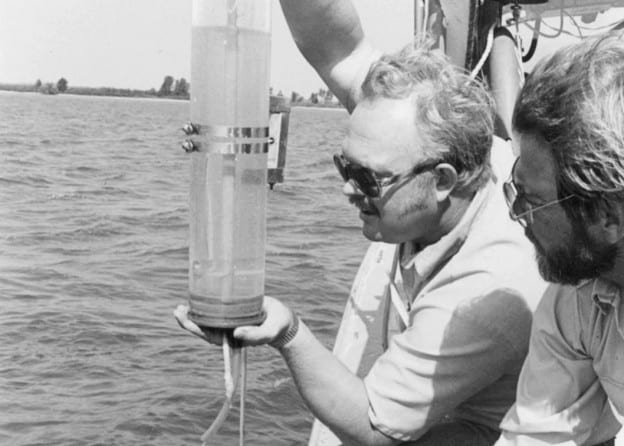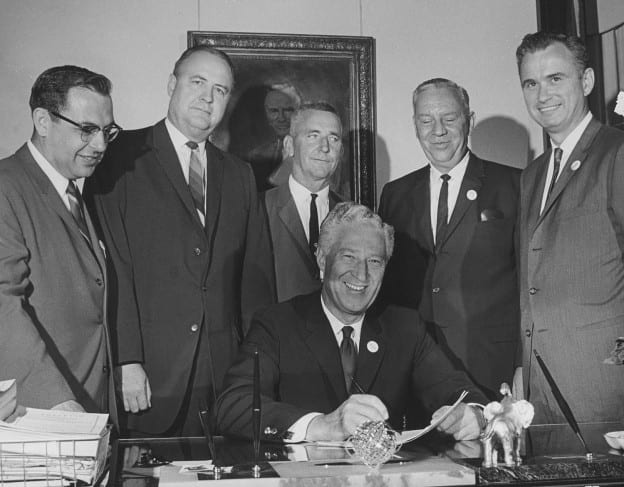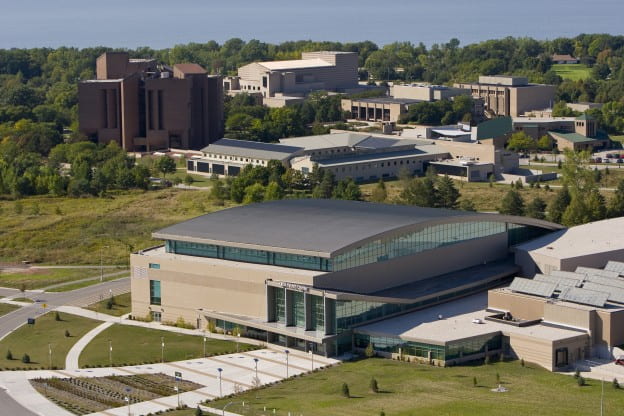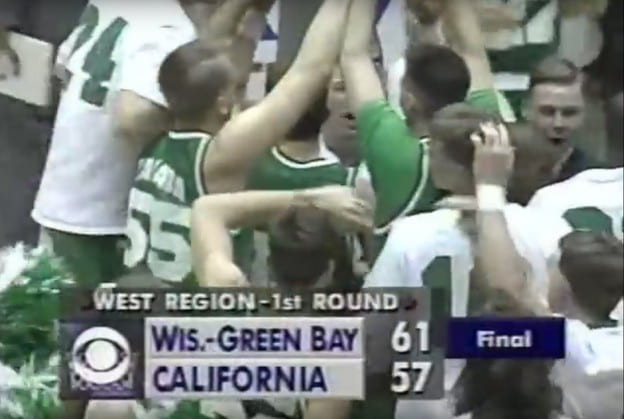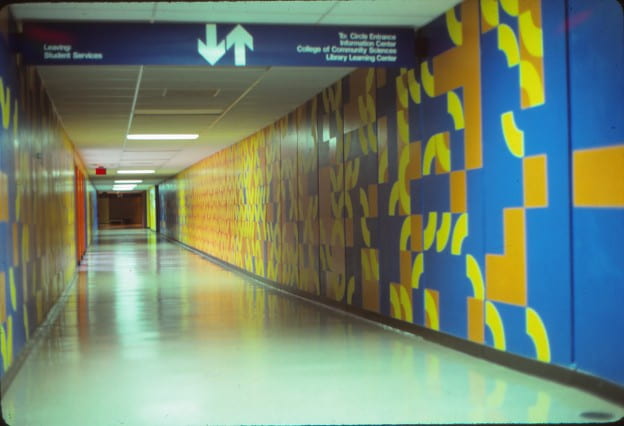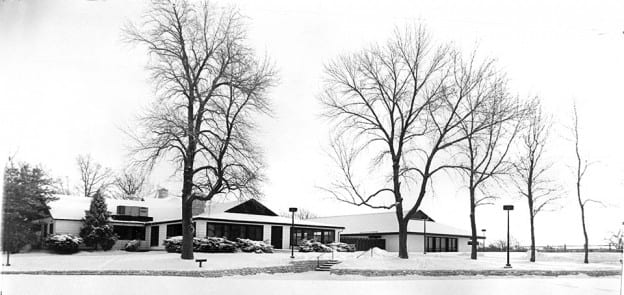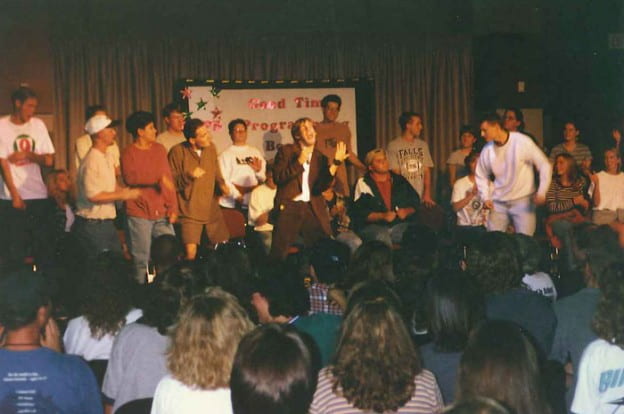The state set plans for the University of Wisconsin-Green Bay in motion in 1965 with legislative approval, but the school wouldn’t have its first employee until Oct. 6, 1966. That’s when the UW Board of Regents ratified President Fred Harvey Harrington’s decision and announced the appointment of Dr. Edward W. Weidner, 45, as chancellor. Weidner was a rising star at the University of Kentucky with significant international experience as both a political scientist and leader in developing new models for higher education. Weidner was also highly accomplished for one so young, by the standards of academia. He had achieved the rank of full professor and chair of political science at Michigan State at the age of 31. By early 1967 Weidner was on the ground at the Shorewood site, the future home of his new University, and staking out plans for new hires, an innovative academic plan and rapid-fire construction of new academic buildings. Weidner would serve 20 years as UWGB chancellor, stepping down on the last day of June 1986. He remained an active presence at the University he founded for most of the remaining two decades of his life.
Eco U®
In 2010, UW-Green Bay obtained trademark rights to the words “Eco U.” The move by Chancellor Thomas Harden both honored the University’s ecological roots and protected the institution’s rights to the nickname first bestowedat its founding. In fall of 1969, reporters from the Associated Press, the Chronicle of Higher Education and Harper’s and Innovation magazine all trumpeted the new UW-Green Bay as a national model for innovative, environmentally focused higher education. While founding Chancellor Edward Weidner would years later say the media wrote too narrowly about UWGB’ ecology focus — “The Man and His Environment” theme was much broader and included the social science, business and cultural environments, he said — campus officials didn’t much protest when a lengthy article in the February 1971 issue of Harper’s magazine extolled UWGB as “Survival U.” Contributing editor John Fischer described a University “where all work would be focused on a single unifying idea, the study of human ecology and the building of an environment in which our species might be able to survive.” He called it “the most exciting and promising educational experiment that I have found anywhere.” Reprinted in the Press-Gazette, it spawned related articles across Wisconsin, in other U.S. publications and even abroad (the Cape Times of South Africa.) When Newsweek dubbed the campus “Ecology U,” the name stuck. Inquiries about the University flooded in from the East Coast and from overseas. Earth Day and the federal Clean Water Act resulted from the national, early-1970s wave of activism but before the decade was out, the Oil Crisis and a worldwide economic slump took some of the wind out of the environmental movement’s sails. UWGB, however, retained strong academic programs in the environmental and natural sciences, a reputation it maintains to this day.
9-2-65 the culmination of long community campaign
Wisconsin Gov. Warren Knowles authorized a four-year university for Northeastern Wisconsin when, on Sept. 2, 1965, he signed Senate Bill 48, with Green Bay area elected officials Robert Warren, Jerome Quinn, Cletus Vanderperren and civic leaders John Borgenson and Rudy Small looking on in approval.
The 1965 creation of UW-Green Bay culminated a community campaign bubbling since at least 1958, when then-Gov. Gaylord Nelson entertained the possibility of a new regional university. At that time, Green Bay already had its own two-year UW center, “Cardboard Tech,” located in a World War II ordnance building near East High School since the late 1940s. By 1961, when the new $1.3 million Extension building opened on Deckner, the two-year Green Bay Center (enrollment 500) was the second-largest of UW-Extension’s eight freshman-sophomore feeder centers, and the fastest growing, on pace to reach nearly 1,000 by the mid-1960s.
The Brown County Board of Supervisors, in 1963, petitioned the Regents to locate a campus at Green Bay. By the following spring, a Green By Area Chamber of Commerce committee headed by Small was collecting data on the region’s unmet demand for higher education. John “Jake” Rose, president of Kellogg Bank, led efforts behind the scenes to acquire land and raise private funds.
Cofrin, Kress names stand tall on campus
Famous names from Green Bay’s rich history identify several of the University’s signature programs and facilities. The David A. Cofrin Library. The Kress Events Center. Mary Ann Cofrin Hall. The Weidner Center for the Performing Arts.
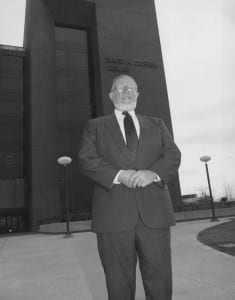
The Cofrin name is particularly prominent across campus. Family patriarch Austin E. Cofrin founded the Fort Howard Paper Co. in Green Bay in 1919. He died in 1980 at the age of 96 after making Fort Howard the world’s largest papermaker. Austin’s son, Dr. David A. Cofrin, and his wife, Mary Ann, struck up a friendship with UWGB Founding Chancellor Edward Weidner and went on to make dozens of contributions including a half-dozen gifts of seven figures or more, across a range of academic fields, nature-conservation projects and fine arts initiatives. It began with the campus arboretum and continued through student scholarships, named professorships, the opening in 2001 of the University’s primary classroom facility, and completion in 2007 of the campus recreation and events center. Most prominently, in 1987 the couple announced a challenge gift (eventually to total more than $5 million) for a public campaign for a state-of-the-art performing arts center they insisted would be named for their friend. The Cofrins later funded construction of a $4.6 million addition to the Weidner Center, completed in 1998. It was a desire to more fully honor the legacy of Austin Cofrin that led Dr. David, shortly before his death in August 2009, to announce a $5.5 million gift to the University. That contribution, the largest single private gift for academics in the history of UW-Green Bay, created a fully endowed chair (an additional faculty position) in business, and funded a permanent, universitywide endowment for faculty development and academic enhancements.
Also inspiring by example is another Green Bay papermaking family whose generosity has boosted generations of students at UW-Green Bay. Ground was broken in late 2005 with ribbon cutting in fall 2007 for the University’s state-of-the-art recreation and events center, the Kress Events Center.
A generous naming-rights gift from the George F. Kress Foundation pushed fundraising past the threshold to start construction on renovation and expansion of UW-Green Bay’s Phoenix Sports Center at a total cost of $32.5 million. George F. Kress was the founder of Green Bay Packaging Inc. and a longtime supporter of education and other community causes.
The Cal Game
UWGB has had plenty of heroic triumphs in five decades of intercollegiate athletics but — considering the stakes, the context, the national TV audience and the high-flying, NBA-prospect-laden opposition — no greater day than March 17, 1994. The Phoenix shocked the nation and NCAA Tournament predictors everywhere by slaying the California Golden Bears, 61-57, in a first-round game in Provo, Utah. With future lottery picks Jason Kidd and Lamond Murray, streaking fifth-seeded Cal had been a darkhorse pick to make the Final Four. Defensive specialists Gary Grzesk and Eric LeDuc forced the two stars into awful, turnover-filled shooting games, Jeff Nordgaard supplied the points, and point guard John Martinez calmly handled the pressure all day. Dick Bennett, already respected by his peers, became a national name; the Pep Band charmed with its enthusiasm; Phoenix Phever caught on statewide; and UW-Green Bay became the darling of the tournament’s opening weekend, eventually pushing a stacked Syracuse team to the limit before falling in the final minute in the next round. Making it all more enjoyable for Green Bay fans: the anguish of the vanquished. “Something called Wisconsin Green Bay stunned the West’s fifth-seeded team in the opening round,” the LA Times offered in its game recap, and then summed up the Phoenix like this: “The boys from the land that vowels forgot, or distributed unevenly, had UWGB on their uniforms and names such as Grzesk and Nordgaard. Their pep band wore cheese heads… The only way a Phoenix player–Wisconsin Green Bay’s nickname is the Phoenix–is ever going to get into a lottery is to go to a store and buy a ticket.”
From ‘no dorms’ to nicest, campus grew

In its earliest days in the 1970s, UWGB was generating national buzz as an innovative university. There was one critical area, though, where being different would be difficult: Dorms. Other colleges and universities had them. UWGB didn’t. In 1970, a private developer opened the Bay Apartments on Circle Drive land not yet owned by the University. The nine buildings were often less than their 540-bed capacity and not fully accepted by parents of high schoolers who anticipated supervised halls and meal plans. The state refused to fund dorms, killing off several UWGB proposals because some dorms at other campuses were sitting empty. In 1984, UW-Green Bay announced its first capital campaign, headed by co-chairmen Donald J. Long and James A. Temp. The $2.2 million drive yielded the upfront money for a loan that could be used for construction of the University’s first four residence halls, housing 240 students. The key piece was University Village Housing, Inc., a limited-purpose foundation formed by Donald Harden, Jack Robishaw and others specifically to build campus housing. Freed from state restrictions, builders could offer reasonable rents yet nicer amenities — a private bathroom for every two-person room — that gave UWGB’s Residence Life complex a competitive advantage. Overall campus enrollment grew significantly. Today’s on-campus population is nearly 2,100.
Macaroni Hall: one big psych job
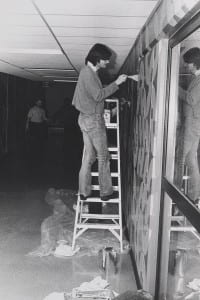 Hey, it was the ’70s. Few architectural features or interior design elements of the mod new UWGB campus turned more heads than the corridor dubbed “Macaroni Hall.”
Hey, it was the ’70s. Few architectural features or interior design elements of the mod new UWGB campus turned more heads than the corridor dubbed “Macaroni Hall.”
Completed in 1973 to connect the Library-Learning Center with the new Student Services Building, the gray concrete tunnel’s first paint job consisted of colorful geometric shapes that looked a lot like… well, macaroni. Psychology Profs. William Smith, Per Johnson and Design Profs. Ronald Baba and David Damkoehler worked with students on the repeating pattern meant to make the corridor more appealing by visually separating it in two. Legend has it there was only one full “O” in the entire 30-yard array. Any results of the experiment were lost to history, as was the paint job, covered over by the mid-1980s.
The Rathskeller
When the University Commons opened in the late 1970s, the Rathskeller was an instant hit. Students were immediately introduced to the science of risk/benefit analysis: Too much time shooting pool and lingering with friends promised immediate reward but might imperil your GPA. The Rathskeller survives today, sort of, as the Phoenix Club.
Shorewood Club
It fell into disrepair and was torn down in 1987, but ask any 1970s Era alumnus of UWGB for his or her favorite memories and it’s almost certain to include the word “Shorewood.” On an under-construction campus that had few buildings at all until the mid-1970s, the former Shorewood Country Club clubhouse was a mecca for students, serving as the student union and semi-official hangout.
All-time UWGB favorite
Like a swallow to Capistrano, hypnotist Jim Wand has been returning to campus each fall with his crowd-pleasing, persuade-student-volunteers-to-follow-amusing-suggestions routine since time immemorial. We couldn’t locate a date for Wand’s first visit — fittingly, nobody seems to remember — beyond a 2009 article that said his annual show had been a student union staple for “25 or 30 years.”

